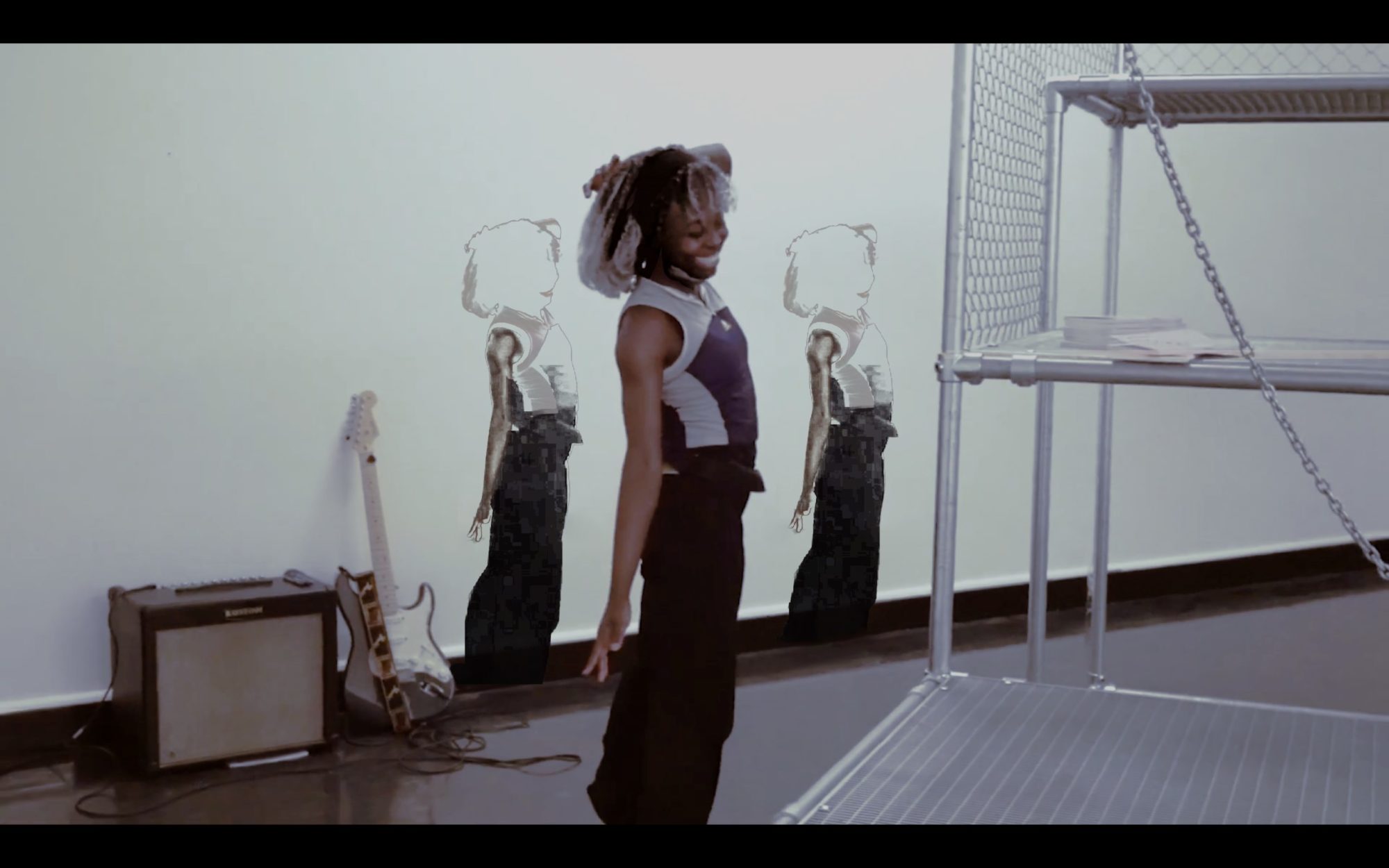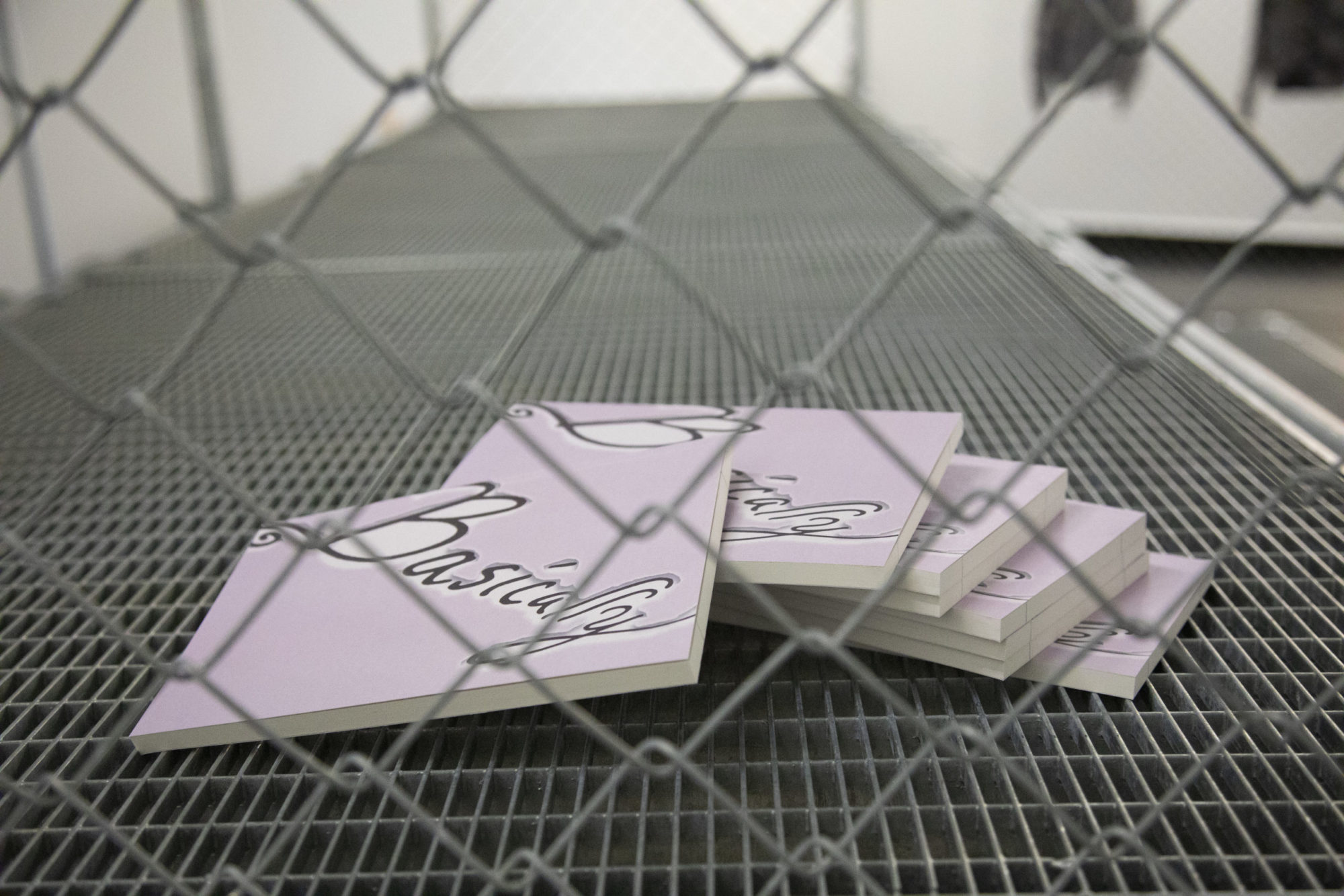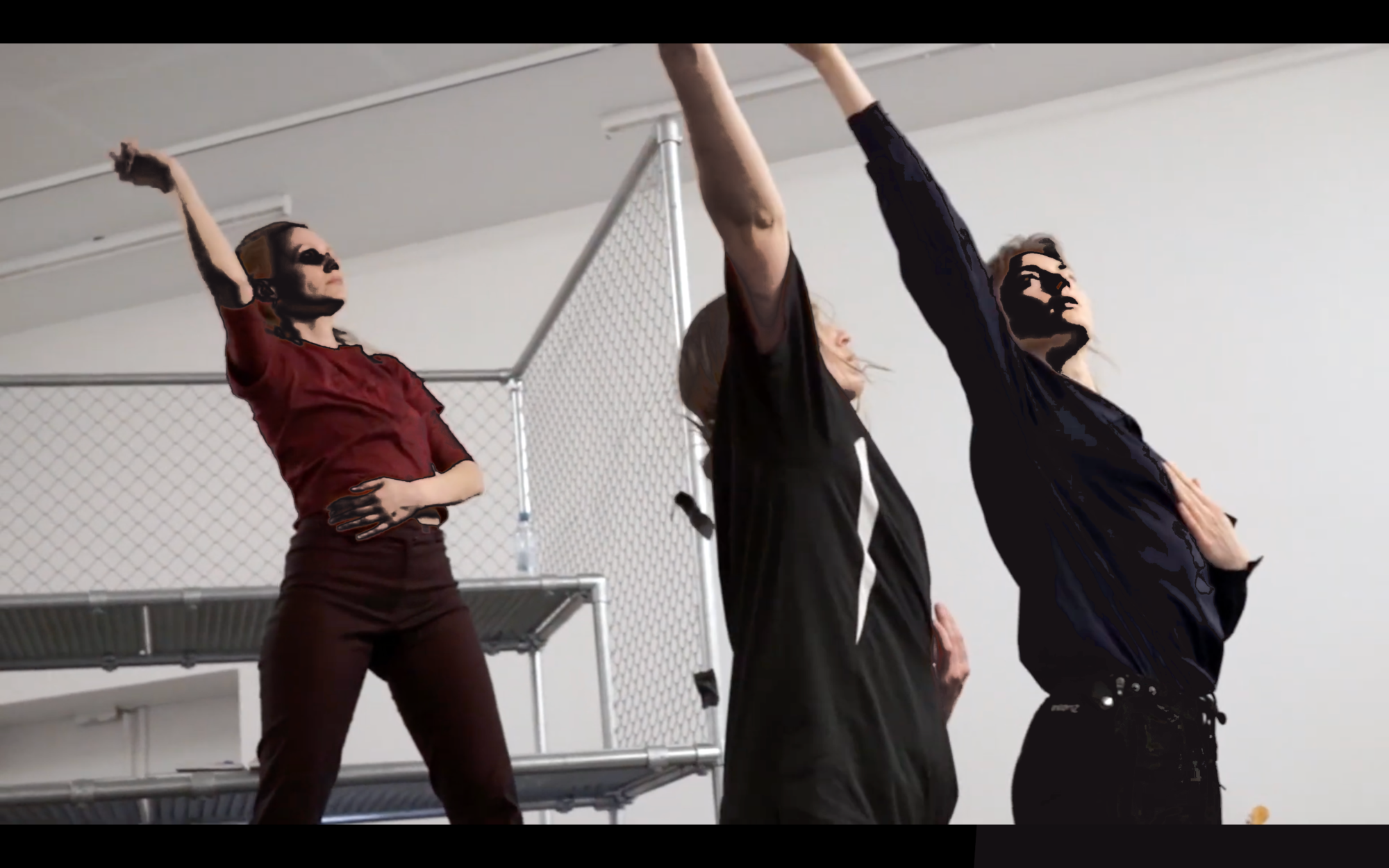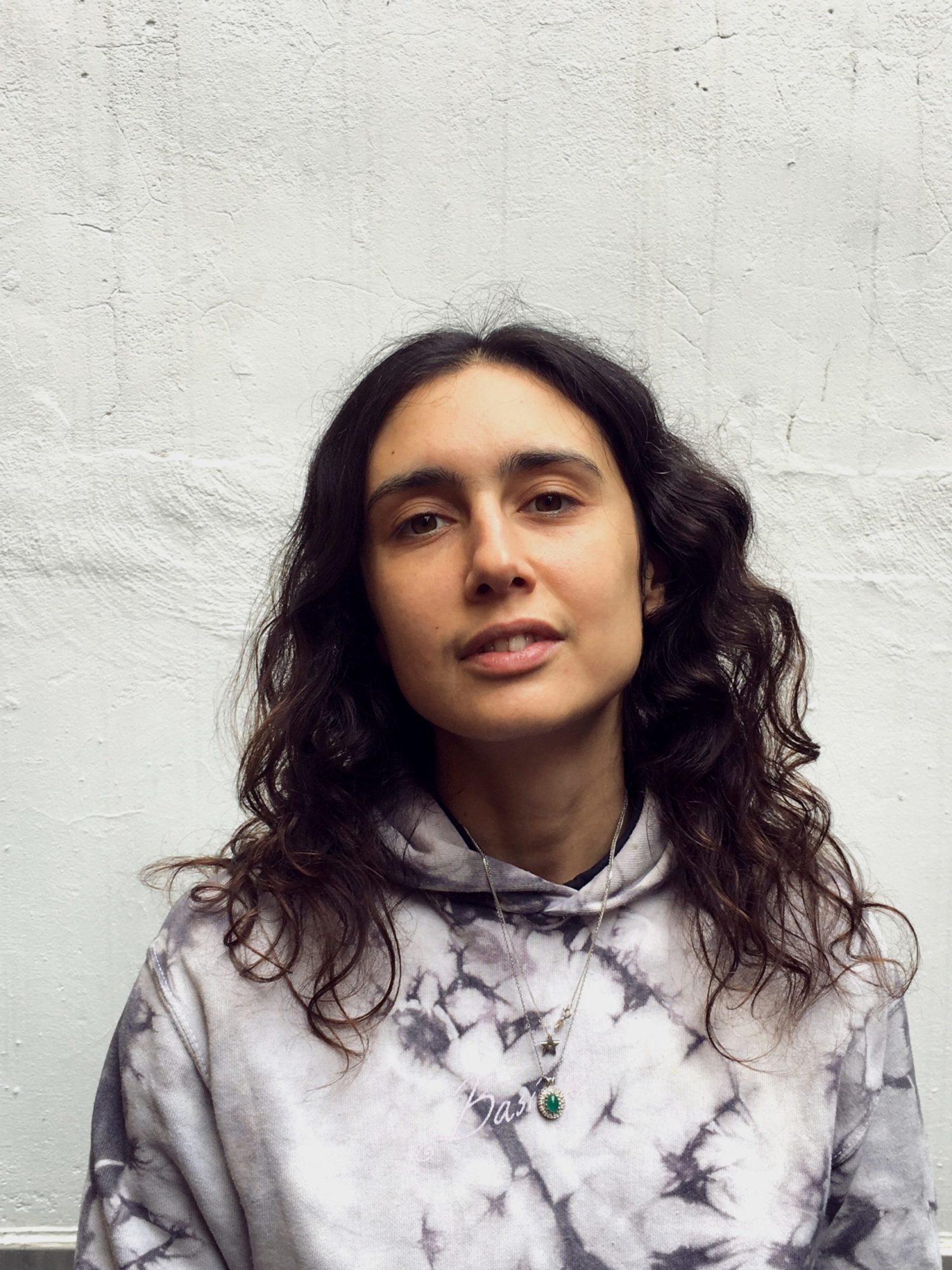Nikima Jagudajev: Getting To Know Each Other in Public
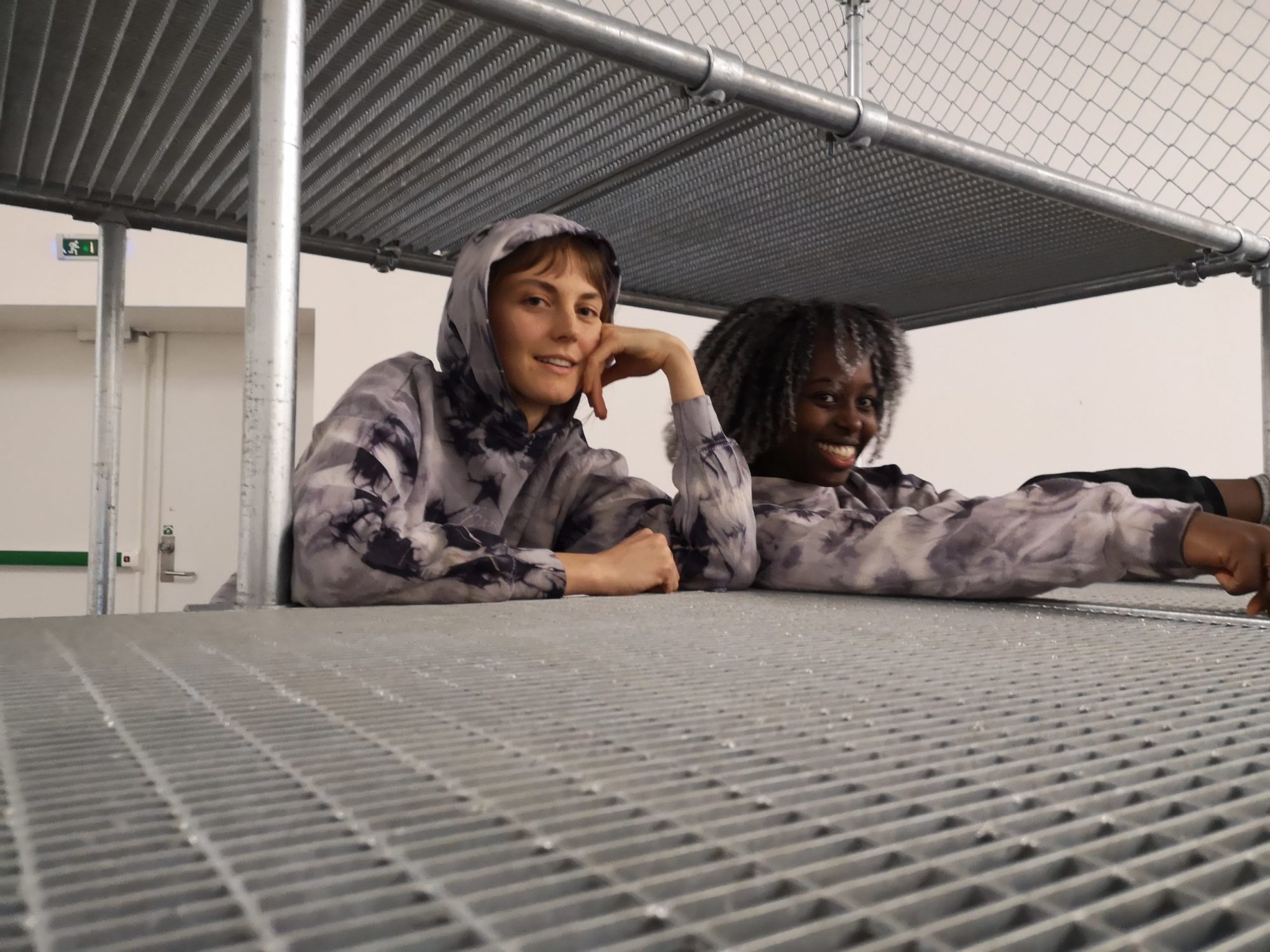
(From left to right) Amalia Wiatr Lewis and Shelmith Øseth [photo: Salomon Poutsma; courtesy of Nikima Jagudajev]
Share:
Nikima Jagudajev choreographs the social. In her latest work, Basically (2021), which premiered this winter at Bergen Kunsthall and continued to unfold during a residency at Kunstenfestivaldesarts (May 21–30, 2021) and at Shedhalle Zurich in July, Jagudajev brings together the following elements: Dance, the I Ching, food, Zoom, meditation, live musical performance, time portals, long-term collaborators, new performers, and the audience. What emerge are proposals for ways of gathering, being together, getting to know each other—in front of, and with, an audience. Basically functions as a series of thoughtful, gentle offerings. Her work offers a world that ebbs and flows as the light, the vibe, and the audience shift and change. Jagudajev describes the result—when people can let their guards down—as a shared, “heightened sensitivity.”
I believe it. I met Jagudajev when she was a performer in one of my own works. Nikima is a beautiful dancer and a sensitive, curious person. I was also struck by her ability to soften the situation, to bring flow to the group. Feeling and working with this quality of Nikima’s has affected my own thinking and approach, inside and outside of the work. But where is the outside, really? I ponder this as I listen to the musical accompaniment to Basically, folding my laundry, staring off into space, listening to the whispers and laughter under the guitar riff, communing (it feels like, somehow) even from afar.
“I find the need to reconstruct what I was deprived of as a child. I want to talk about the places where we, as students, breathed life into the walls of the institution and found passion and creativity within the perpetual lack. I call it Re-schooling. The coming together to nurture and share our perversions, to practice dissent, not through speaking about political and social atrocities per se (not that that is forbidden, of course) but rather a prefigurative practice of aufhebung that revels in its proposed friction. We do this by cherishing our interests, connecting with those deep parts of ourselves that shine the brightest and coaxing them out into the world. Sharing our devotions. This is the laughter that fills the halls between classes, the games that take place on the blacktop, the locker decorations, and secrets underneath the bleachers. This, for us, is the anti–bourgeois fuck you, the rejection of taboos, reclaiming gossip, joy, jokes, and sin. This is about the collective action of making space for those sweet particularities, the ones that are snubbed out, relentlessly.”
—Nikima Jagudajev, The Backstreet Boys (co-commissioned and published by Bergen Kunsthall and KarmaKlubb, edited by Olivia Fairweather)
Miriam Simun: Basically—can you tell me about this title? Where did it come from and where is it going?
Nikima Jagudajev: I like a title that is a filler word, without an obvious narrative. I don’t want it to fictionalize the work. I want the title to be an object in and of itself. Basically is many things. It’s elemental, back to the basics, the essential, but it’s also high school girl, affirmative-adverb speech. It’s a way of talking, a way of emphasizing without much meaning but [with] a lot of melody. The design of the logo reflects this [idea]. I was channeling my childhood diaries, the doodles that I made in the margins of my homework, the cover of my elementary school binder, and the endless notes that I’d pass to classmates.
MS: I sense some sorcery or oracle-ity or witchiness in the work, through the I Ching most explicitly, in the “cauldrons of natural dyes” used to tie-dye the sweatshirts, but also in the movement scores. These choreographies—you describe them as “maze-like spirals”—seem to me to be working something like trances … for the dancers, but also for the audience, to really enter, inhabit, [and] participate in this space and vibe you’re orchestrating. I’m really interested in something you wrote in the notes you shared with me: “The transmission of nonlinear choreographies that fold in on themselves like portals through time, orbiting musical scores and prophecies.” Can you tell me more about how you develop these spirals? How do they relate to time, create portals through time, for you? Where does the prophecy come in?
NJ: I will try to explain some of the intricacies of the choreography first. I build [the choreography] linearly to be able to transmit the material efficiently, even though I know that the intention is to ultimately move out of this linearity. Once it is learned from beginning to end, then we go over moments where the material can fold back in on itself—the “portals,” if you will. These are moments in the choreography where the same movement happens at multiple points within the sequence. If we are thinking linearly, movement A, for example, happens at minute one, as well as minute[s] three and four, so movement A becomes a portal that, when danced, brings you to one of these points within the choreography—so does movement F fold in on itself, as well as movement T, etc. Once the practitioner learns all these folds within a sequence, the dancing can begin to happen. It is no longer about getting from point A to point B because the movement infinitely revolves around itself in varying, undetermined patterns, less reliant on choice and structural necessity and more on a force, a sort of electromagnetic pull that settles into a perpetual, but shifting, orbit. So yes, time is important in that there must be plenty of it to get lost in and totally unimportant at the same time as there is no end or limit except for, perhaps, physical exhaustion.
From “Basically” featuring Shelmith Øseth [photo: Salomon Poutsma; courtesy of Nikima Jagudajev]
NJ (continued): The choreography, in this sense, acts as infrastructure that allows the practitioner to let go of control and give themself over to the spirit realm. The dancer can trust that their body is safe within the container. I guess the body is a kind of offering here, to be taken by dance. I think this trance state definitely envelopes visitors, [who can access it] further depending on their wills and intentions, but the setup is also [done] with the intention of making space for the friction that strangers bring, a space that is open to disruption and difference.
If I can describe the outcome a bit, it feels like a slightly heightened sensitivity. Like all my sensorial perceptors are a bit more aware, a bit more awake, than usual, but in a calm way. I think this can be a shared experience if people are willing to let their guards down.
The I Ching is a way in. The oracle works as a kind of locator, a way of situating ourselves within the macrocosm. Laurel Atwell, who has been studying the I Ching for years, and who guides us in our collective castings, describes it as “a way of checking the weather.”
MS: Something I’m really drawn to, but feel quite distant from, as I didn’t get to experience the work in person—in physical embodiment—yet, is the role of clothing and food in Basically. Material things, things that go in and on the body, quotidian things …. How do they fit into the work for you?
NJ: It’s nice that you bring this up after the last question because in a way it is the other side of the coin. While the spiritual aspect of the work is a lonely feat, the material aspect is relational: the threads of social connectivity. Materials such as food, and cauldrons of dyes with their pungent smells and colors, and cotton hoodies—they bring us back to this relationality. Engaging with these elements is not about expressing a deep fandom for the things themselves. In a way it doesn’t really matter what they are, because ultimately, they are social objects, proposals for cultural exchange. Although I do tend toward the mythical because it requires imagination and faith. The materials that we engage with are always in relation to activity, like the process of creation or the act of eating, or talking, or sharing something, or doing something that can be shared later.
It’s important to me that the holy moments aren’t too precious, that they are happening alongside the everyday, connecting our mundane lives with the transcendent. Breathing out is important, sitting in the less exciting moments that seem to go on forever so that we can find a sustainable ease there. Groundedness, commitment, and time are all part of it.
“Basically” notebooks [photo: Kobie Nel; courtesy of Nikima Jagudajev]
MS: I was really struck by this phrase in the description of the work: “Each element works as an informal invitation to engage in different ways, allowing for a dispersal of attention.” There’s so much talk about attention these days, mostly about the lack of it, or the misdirection of it. How do you think [about] dispersal of attention? What is your interest in allowing space for this?
NJ: A dispersal of attention in this context is about having options within the framework, so that visitors and performers have agency over how they partake. This framework developed from a very personal place of not wanting an audience to have expectations of me as a performer. I want to be able to dance for you when the vibe is right, when there is a genuine connection between us, but I also want to be able to disappear in broad daylight, so to speak—to be able to put up that boundary that says, “leave me alone, I’m doing this for me.”
Dispersal of attention is not so much about creating distractions as it is about giving a few options through which each individual can engage, of their own accord, at their own speed, etc. I understand the need to enter a space slowly and become enmeshed gradually. I understand the need to protect ourselves from outside forces; other people’s proposals that are not always safe. I want to offer gentle pathways in. I want it to feel casual, whether you are sitting on the sidelines, having a bite to eat and chatting with a stranger, or lying in the middle of the floor and gazing attentively at the dancing that is happening close by. I want the framework to propose agency through its various offerings, so that you take responsibility for yourself and choose where and how your attention is directed. The hope is that this method keeps the space from becoming homogeneous and stagnant, and instead allows for difference to cohabitate.
(From left to right) Marie Ursin, Alexandra Tveit, Amalia Wiatr Lewis [photo: Salomon Poutsma; courtesy of Nikima Jagudajev]
MS: Thinking about spaces that “allow for difference to cohabitate,” I would love to know more about how you assemble your crew, in this instance the “class of 2021.” You wrote to me previously that the audition was beautiful in itself. How do you create these spaces of intimacy? I love how you write that the performance is, in large part, about “getting to know each other in the context of a public exhibition space.” What kind of practices do you use to set the right tone and environment for this kind of sociality to happen? What does it mean to get to know each other in public, with witnesses?
NJ: Delegating tasks to people in this open environment and trusting that things will fall into place in a way that I can’t completely foresee gives me life. I am asking for some real nuanced stuff here: devotion, heightened perception and sensitivity, a clear sense of one’s boundaries, trust in the framework, hours of meditation that [are] also physically taxing, and also—and I think this speaks to your question about getting to know each other in public—being able to find comfort in the unknown, being able to take care of yourself within a framework that offers support but requires you to find it for yourself. It’s subtle.
It is necessary to develop the work with people over time, but also to integrate newcomers with every new iteration, as a way of locating ourselves in the specificity of place and to allow for change. It’s like a family that just keeps getting bigger, but not everybody is present for every iteration. However, there is always the potential of working together again based on proximity, availability, and one’s passions/skill set. Different elements take precedence at different times, depending on who is involved and where my interests lie at that time. So there are through lines: Aspects of the work that continue over the years, but [are] always affected by forces of change and transition. This dynamic feels important. I’m never like, “Okay, now I’m making a new work.” … With a new context, a new location, new people, a varying emotional state, comes new inspiration. The work moves, it slithers through time and sheds skin and acquires new scales as it goes ….
I guess the tone is being set by the people as well as the dances and the music; the banging DJ tracks, but also the ethereal soundscapes. There is a choreography called Walk in the Park (2018), which I explain to my collaborators as the trunk from which all the other material branches. It came from a video recording of myself and a collaborator hanging out in the studio: a depiction of that particular moment, that particular interaction. But I teach it to others stripped of that narrative so that it exists as a skeleton of a pedestrian interaction. It’s taught only as stark signifiers to make space for the interactions of each practitioner who takes part in this choreography, the singular relation. To say it in another way, Walk in the Park is a choreography that makes space for people to get to know each other; a container that provides some safety within an open ended context that is constantly changing through various encounters with strangers. As I mentioned before, the unknown-ness; the newness; what strangeness has to offer, are very important. I like to create structures that can be fixed but also affected.
MS: As you continue presenting new iterations of Basically at kunstenfestivaldesarts and Shedhalle Zurich this summer, what are you learning about these structures you’re building—thoroughly choreographed, but also made to be affected—that guide our modes of gathering and being together?
NJ: Working with a group of people [who] have varying skill sets requires a real attentiveness on my part. How do I delegate? How do I divide my attention? How much responsibility can I leave with individual practitioners? How much does the work rely on my presence, my energy, and my discipline? These are all questions that activate me, especially at the beginning of each new iteration. Not being physically present for the last two weeks of rehearsals and shows at the Bergen Kunsthall was a real test of faith. I was awestruck by the fact that the system was still able to run without me, that I could give so much over to the people [who] were actually present. It’s always a pleasant surprise to know that I am not the only one [who] cares, that others are also committed to taking part, that they find purpose in my proposal, that they also want to be there. I couldn’t do it without them. Relinquishing control teaches me a lot.
Portrait of Nikima Jagudajev [photo: Melanie Matthieu]
Miriam Simun is an artist working at sites of collision: the collision of bodies (human and non-) with rapidly evolving techno-ecosystems. If collision can be understood to be a form of disturbance (in the ecological sense), then in disturbance we move through damage to an opportunity for renewal. Simun works with the sensual conditions of this renewal. Spanning multiple formats, including video, performance, installation, and communal sensorial experiences, her work has been supported by Creative Capital, Robert Rauschenberg Foundation, Joan Mitchell Foundation, and Foundation for Contemporary Arts, and can be found at miriamsimun.com.
